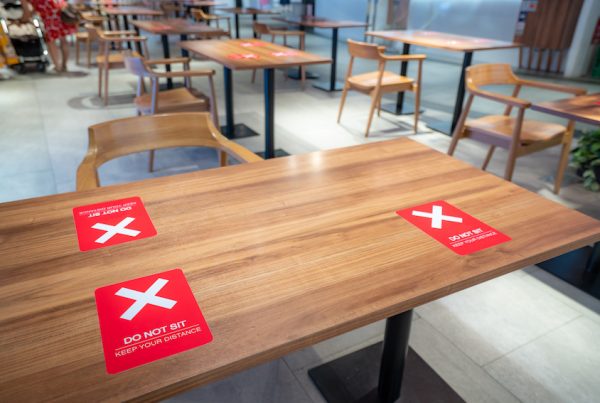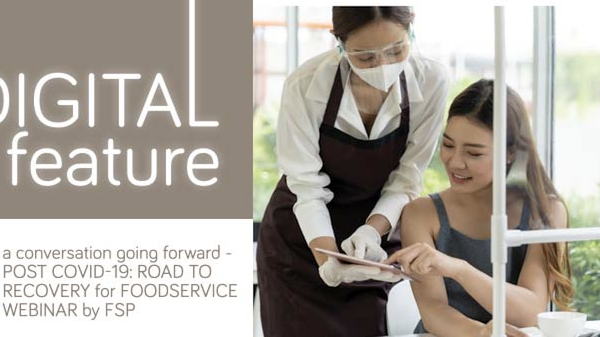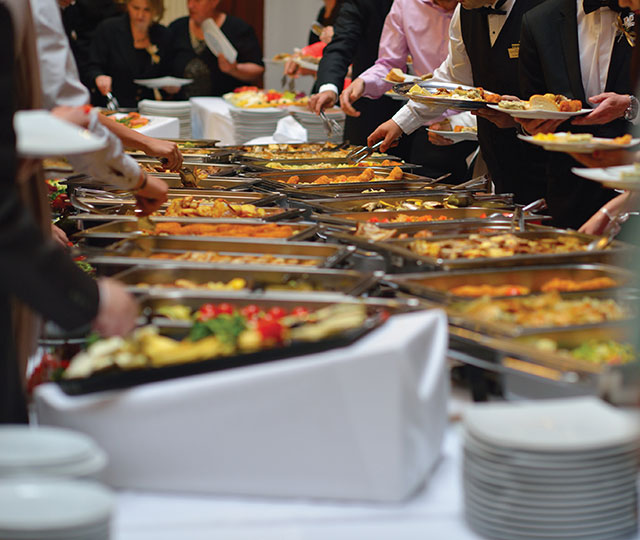
The self-service side of food and beverage could be tracked back to 16th century France where guests serve themselves from various dishes laid out before them. This practice proved beneficial for operators as they could cook at one go and cater to a large number of guests. It also gave diners a more casual dining experience and became a hit for occasions and large group gatherings. Plus, the idea of paying only one price and eating all you can was enticing; as the buffet line tends to span myriad cuisines.
Of course, we all know that self-service expanded its definition according to trends and lifestyle – fast food, anyone? In the recent years, it has also emerged in hypermarket delis where operators are offering cooked food to-go or usually known as ready-to-eat (RTE) food. While you might have seen roast chicken on the rotisserie for a while, we are beginning to see more cooked items; from salads, pastas to stir-fries in its deli segment. It is an option between fast food and frozen cooked items; catering to consumers’ desire of eating fresher and getting a balanced meal amidst convenience. Even some restaurants have rolled out this option to enable diners to have a quick meal or order ala carte. No matter the setting, there are practices in food safety and freshness that cannot be negated when it comes to bringing a fullservice meal to a self-service environment.
Customers cannot tell if food has been exposed to risky elements just by looking at it although there might be possibility that the food has gone above its safe-forconsumption levels. This is why operators are suggested to run on the Hazard Analysis and Critical Control Point (HACCP) standard of food safety. The preventive approach addresses physical, chemical and biological hazards as a means of prevention instead of finished product inspection. A guide to a food safety plan as follows and find out how equipment can assist in improving the standard of food you serve.
DEVELOP A FOOD SAFETY PLAN
All steps will be monitored to identify potential food safety hazards in order to take actions to reduce or eliminate risk of contamination. Based on the HACCP guidelines, the plan can be adapted to fit your menu, customers, equipment, processes and operations.
01 ANALYSE POTENTIAL HAZARDS
A flow chart detailing all handling and preparation steps from receiving to service that lists possible hazard occurrences and its consequences at each step. Think about how you can prevent the hazard, for example, bacteria, viruses and parasites. You would not have to factor in low risk and unlikely hazards.
02 WHERE IS THE CRITICAL CONTROL POINT (CCP)?
CCP means the point where the identified hazard can be prevented, eliminated or reduced to non-dangerous levels. CCPs include process of cooking raw meat or keeping rice at the right temperature to prevent bacterial from sprouting.
03 SET CRITICAL LIMITS
In order for food to be safe to eat, the operator must ensure that temperature, time, water activity and pH are of appropriate levels to prevent, eliminate or reduce the identified hazard at the CCP.
04 ESTABLISH MONITORING PROCEDURES
Set aside specific times to measure if CCP is under control and methods that can be used include visual observations, time assessment, pH measurements, temperature measurements and water activity measurements.
05 SET CORRECTIVE ACTIONS
This outlines what to do should food fail to meet the critical limit. In cases of meat not being cooked right, the procedure needs to detail the correct temperature required. Sometimes you might need to throw food out. All corrective actions taken by staff should be recorded.
06 VERIFICATION PROCEDURES
• Determine critical limits at all CCPs are acceptable
• Ensure the HACCP Plan is properly implemented in the establishment
• Get the regulatory personnel to review the plan is suitable and correctly implemented
• Check accuracy of all monitoring equipment
07 ALWAYS KEEP RECORDS AND A
HACCP PLAN SHOULD HAVE:
• List of HACCP team and their responsibilities
• Each menu item described
• Flow chart for each item indicating CCPs
• Hazards associated with each CCP and preventive measures
• Critical limits
• Monitoring procedures
• Corrective actions plans
• Record keeping procedures
• Procedures to verify the HACCP Plan
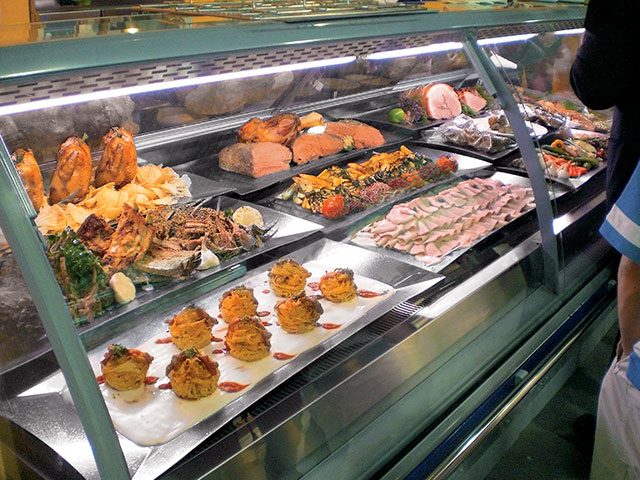
MONITORING FROM THE START
With its Food Safe Control* feature, chefs just need to select the food category and the function will act as the supervisor throughout the cooking process. The 6-sensor probe is a thermometer that works together when FCS is activated to calculate if the food has been adequately cooked. If a red flag appears, it will calculate the extra cooking time required to reach the safety level. It calculates variables in terms of core temperature and cooking time and how they are combined to achieve the pasteurisation factor or F factor. The F factor is the internationally recognised parametre that evaluates reduction of bacteria content and shows the time necessary to destroy microorganisms by thermal effect. FoodSafe Control manages to classify various foods and its bacterial risk for easy management; even for the inexperienced. FoodSafe Control Plus* is designed for foods with a high risk of contamination like meat rolls, ground meat, poultry, pork, fish while FoodSafe Control* monitors items with standard risk of contamination like whole pieces of beef.
www.electrolux.com/professional

Complete solution for ready-to-eat foods in supermarkets with
Electrolux air-o-convect Touchline oven and servery line
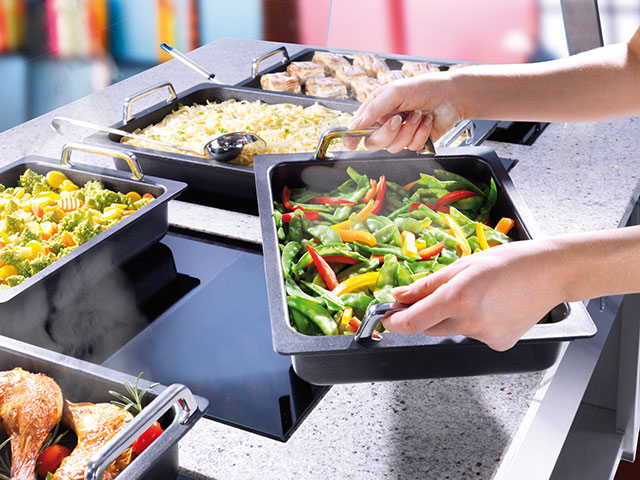
Garland’s striking induction panels maintaining safe temperatures
THE TEMPERATURE PROCEDURE
Food on a self-service line will be cooked ahead and kept at optimum temperature throughout serving times to prevent the growth or development of bacteria. Regulations dictate that hot foods and cold foods must be served separately on the buffet line:
• Always replace a new tray of freshly cooked food onto the hot holding equipment but never add it to the existing tray as it may result in contamination.
• Use a food thermometer to measure the food’s internal temperature every two hours.
• Food that was not maintained at 60°C or higher should be discarded after 4 hours.
• A hot-holding equipment (bain marie) should not be used to reheat food as food need to reach internal temperature of 74°C before being transferred to the holding phase.
• Stirring the food at intervals helps distribute heat evenly through the pan. Garland Induction Hold-Line

Garland’s striking induction panels maintaining safe temperatures
The Green Heat element paves the way for efficient and quick heating as it only generates the precise amount of heat to the cooking vessel that is placed upon it. This contributes in energy savings when the amount of radiant heat is greatly reduced. With Real Time Temperature Control System (RTSCmp) communicating with the generator, each individual tray of food will receive the amount of power to adequately maintain temperature. The induction Hold-Line can be used with any materials therefore prepared food in any type of vessel can be transferred directly to the serving line. Improved sensors on the surface plates results in better temperature consistency especially if a greater variety of pans are used to hold food.
www.manitowocfoodservice.com
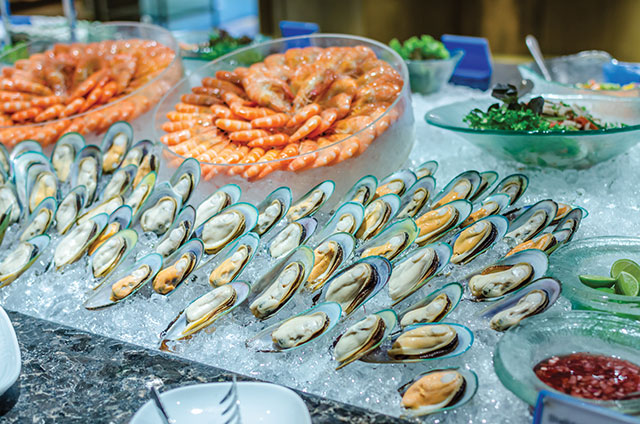
• Cold food items must be below 5°C and its internal temperature checked ever y two hours to ensure temperature is maintained.
• All cold items must be placed on pans or plates, if using ice as the cooling agent. Some items however are acceptable to be placed directly on ice such as shellfish. The ice used for display, when melting, should have an outlet to automatically drain off. Self-service in the industry can be a winning formula for operations and customers as a restaurant will be able to better cope with labour. You do not need to employ more wait staff to take orders and serve the customers but it is important that the crew is well-trained to maintain foods on the line in their best environment. Consumers take easily to the idea of self-service as they have more autonomy on what goes on their plate and this service can be adapted easily; whether for a long dining session or a quick nutritious meal.
References:
http://restaurants.about.com/od/restaurantconcepts/a/buffets.htm
http://www.foodsafetysite.com/resources/pdfs/EnglishServSafe/ENGSection10.pdf
http://www.profoodsafety.org/images/english/Hot%20and%20Cold%20Holding%20Temperatures%20fact%20sheet.pdf








